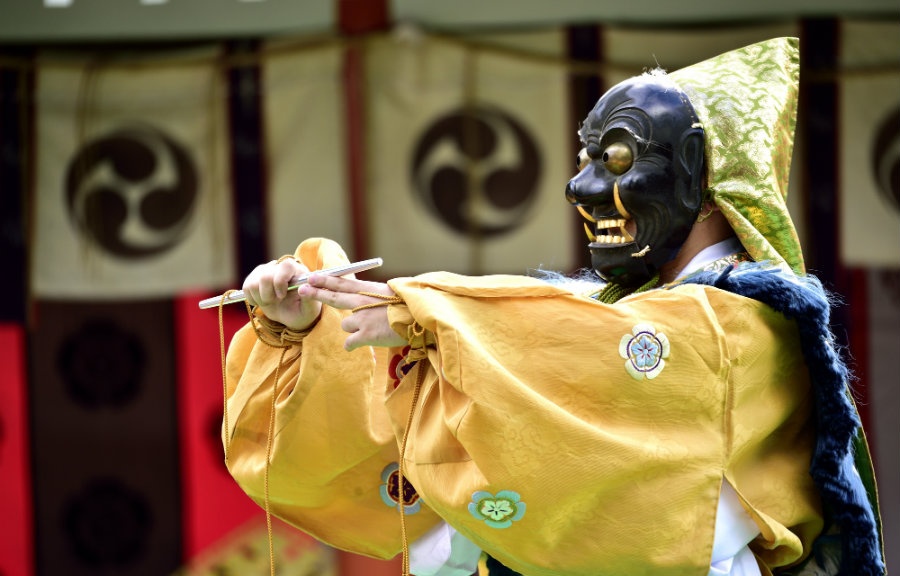Full List—Japan's Intangible Cultural Heritage

Beyond its 20 spectacular World Cultural Heritage Sites, Japan has 21 traditions recognized by UNESCO as elements of Intangible Cultural Heritage. Selections range from traditional dances, festivals and performing arts to hand-made fabric and paper production techniques—as well as only the second national cuisine to ever be recognized by UNESCO.
By Michael Kanert1. Nogaku Theatre
https://www.youtube.com/watch?v=o--VbWf6M0c
Noh developed in the 14th century along with a form of comedic, interstitial theater called kyogen. While Noh is performed in a very stylized fashion, with actors wearing masks and singing in monotone as they perform slow, ritualized movements to music, kyogen consists of spoken comedic skits focusing on the day-to-day lives of commoners. Nogaku, the term for the two arts combined, was first recognized as a Masterpiece of the Oral and Intangible Heritage of Humanity by UNESCO in 2001. When the Intangible Cultural Heritage list was initiated in 2008, Noh was automatically inscribed among the first listings, along with kabuki and bunraku (see below).
2. Ningyo Johruri Bunraku Puppet Theatre
https://www.youtube.com/watch?v=kEUQNvn8EJQ
Bunraku is traditional Japanese puppet theater. Not aimed at children, it's a serious art form that largely evolved out of Osaka during the Edo Period (1603-1868). A bunraku puppet is about half the size of a human, operated by three people who dress all in black but are otherwise in clear view of the audience. The head puppeteer controls the head and right hand, while the other two puppeteers operate the left hand and legs. The story is narrated in a form of chant called joruri, accompanied by the music of shamisen. As with Noh, Ningyo Johruri Bunraku Puppet Theatre was recognized by UNESCO first as a Masterpiece of the Oral and Intangible Heritage of Humanity before being inscribed as an element of Intangible Cultural Heritage in 2008.
3. Kabuki Theatre
https://www.youtube.com/watch?v=hlTQUzPZU8Y
Kabuki is believed to take its name from the verb kabuku, which means to lean or to be unusual—though the three kanji that make it up, 歌舞伎, mean sing, dance and skill, respectively. Marked by stylistic performances and elaborate makeup, kabuki developed during the Edo Period (1603-1868) and has continued largely unbroken to this day. Along with Noh and bunraku, kabuki was recognized as a Masterpiece of the Oral and Intangible Heritage of Humanity until it was included as an element of Intangible Cultural Heritage in 2008.
4. Gagaku
https://www.youtube.com/watch?v=TEvjpF17D3M
Gagaku, imperial court music and dance, was one of 14 elements of Japanese culture inscribed by UNESCO in 2009 (one of these elements, Sekishu-Banshi, was ultimately incorporated into the washi listing in 2014; see below).
Gagaku is a fusion of various music and dance styles that came to Japan through Korea and China along with the influx of Buddhist traditions beginning around the fifth century, coming to its peak around the 10th century. It's characterized by slow movements and high-pitched, droning music played on an assortment of wind instruments, the stringed koto and biwa, and various drums and gongs. There are three kinds of performance that make up gagaku: kangen (purely instrumental music), bugaku (music and dance) and kayo (chanted poetry and songs). It's performed at banquets and ceremonies in the Imperial Palace and on special occasions in select locations.
5. Ojiya-chijimi, Echigo-jofu: Techniques of Making Ramie Fabric in Uonuma Region, Niigata Prefecture
https://www.youtube.com/watch?v=sAkDrAHe3Y8
Ramie is a flowering plant native to East Asia. With strong natural fibers, it's been used for fabric production since the days of ancient China—and possibly even for mummification in ancient Egypt. In Japan, ramie cloth was called jofu, with production in Niigata Prefecture (formerly known as Echigo) documented as early as the mid-eighth century. It can be woven into a lightweight, open-weave pattern of fabric that's ideal for humid climates.
A crinkled, crepe-like variant of jofu, called chijimi, was developed in the nearby city of Ojiya around 1670. It is these two traditions, Ojiya-chijimi and Echigo-jofu, that have been recognized by UNESCO. A key element of their production makes use of Niigata's deep snowfall, where the fabric is washed, massaged and then laid out on snow-covered fields for 10 to 20 days to be lightened by the sun.
6. Koshikijima no Toshidon (Kagoshima)
https://www.youtube.com/watch?v=NACjXXM9T6I
The Koshikishima Islands (renamed from Koshikijima in 2014) are a group of a dozen islands located in the ocean to the east of Kagoshima Prefecture. The largest island, Shimo-Koshikishima, is home to Koshikijima no Toshidon, held every New Year's Eve. Groups of two to five men don straw raincoats and terrifying, long-nosed masks to pose as visiting deities called Toshidon. They knock on doors and ask to see the children of the house, scolding them for any bad behavior and advising them to mend their ways. With declining population on the islands (only about 5,500 remained as of 2011), it's unclear how much longer the tradition will be able to continue.




